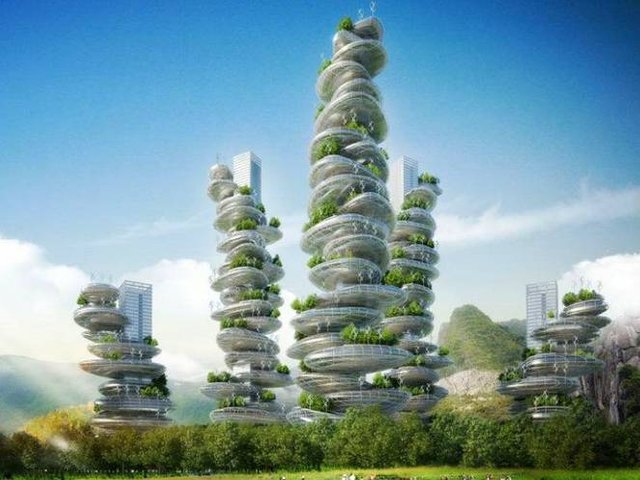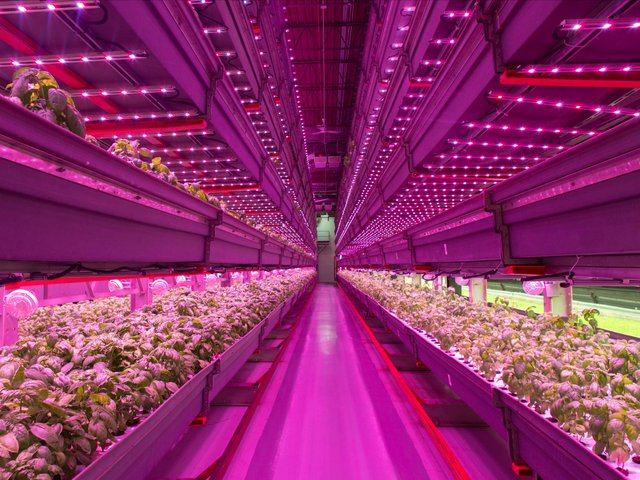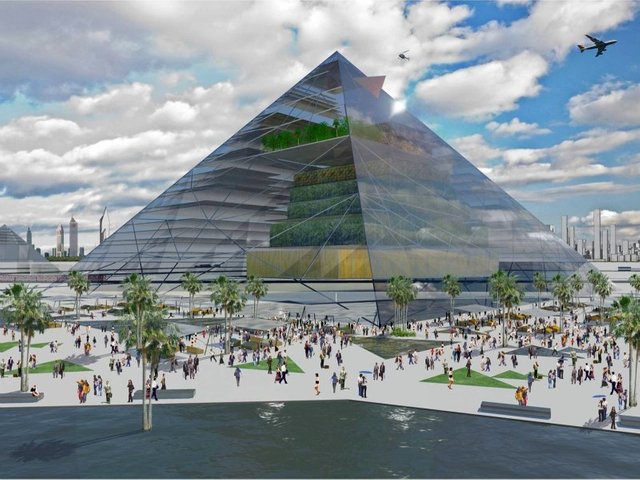A Sustainable Food Dialogue : An Overview of Vertical Farming

Advances in farming over thousands of years have steadily allowed for stable population growth. From a world population of 1 billion in 1806 to a population of over 7 billion people today, it is clear that population growth is happening along an increasingly steep curve. The UN estimates that the world's population will surpass 9 billion people by 2050. While we have managed to keep pace with food production, we are quickly depleting our farming resources. This is where the idea of vertical farming comes into play.
The Idea
Vertical farming is exactly what it sounds like: farming done in closed environments that grow upwards instead of outwards. This has taken the form of skyscraper greenhouses.

Advantages
The advantages to this form of farming seem readily apparent.
Since they grow upwards instead of outwards, they are about as efficient as possible per square acre.
It eliminates the need to turn previously unused land into new farmland.
As vertical farms are closed environments, they can be built anywhere and thus allows for gross reduction in the need for shipping produce. This in turn reduces transportation costs, as well as the negative environmental side effects of current shipping practices.
The closed and hydroponic nature of vertical farms means they grow produce very efficiently.
Vertical farms use only about 10% as much water as that required for traditional outdoor farming, and 20% less than conventional hydroponics as frequently used in greenhouses.
It also means that all food can be organic. In such a tightly controlled environment pesticides, sprays, and herbicides become unnecessary.
As the plants are grown under artificial lighting, energy absorption can be optimized.
It allows for the repurposing of old and unused buildings, optimizing the use of urban spaces.

Disadvantages
Vertical farms tackle the issue of food production, but food processing is another step that is necessary for a large number of the products we consume. In order to truly scale down on transportation costs as I had mentioned above, it would also be necessary to move food processing plants closer to cities.
Since these vertical farms make it difficult to reliably use natural sunlight, most products will need to be grown using artificial lighting. All the models created so far have been run on LED lightbulbs, which tend to run (at least for now) on the expensive side. Further, researchers have suggested that it would require unreasonable amounts of energy to run such lighting year round if we desired to truly replace our traditional farming methods with vertical farms.

Deeper Issues
While the concept of vertical farming is an alluring one, some researchers argue that vertical farming only functions as a bandaid to the deeper problems of food supply and distribution.
As of 2015, as much as 40% of produce grown in the country is never sold because it does not meet aesthetic standards set by the industry. If there is a small blemish or bruise on produce, it is simply discarded as unusable.
We function in a system where global food scarcity is more of an issue of geopolitics than it is of actual scarcity. The fact that large portions of the globe are incredibly food scarce while other portions (like the US) have the freedom to throw away almost half of what it produces points to the fact that producing more food will not solve world food issues.

Conclusion
There are very clear and tangible benefits to implementing vertical farming, including the facts that it can be built anywhere, can grow almost anything, and have very high food yields compared to traditional methods of farming. I feel that the main energy issue barring the ability to make widespread use of vertical farming is something that will only take a matter of time to solve, as we develop and refine forms of renewable energy to be more and more efficient. However, it is important to take these positives with a grain of salt and to remember that vertical farming, while highly promising, will not be the solution global hunger.
As mentioned above, it is vital to look at the politics behind hunger. Often hunger is due to distribution problems rather than supply shortages. As stated in a 2008 report by the United Nations Conference on Trade and Development and United Nations Environment Programme, titled Organic Agriculture and Food Security in Africa, food security is not based on food supply but rather “what is important is who produces the food, who has access to the technology and knowledge to produce it, and who has the purchasing power to acquire it”. The issue of supply versus distribution of food will be covered in a future post. I hope you've enjoyed this post, happy Thursday!
Sources
http://www.verticalfarm.com/?page_id=36
http://www.verticalfarms.com.au/advantages-vertical-farming
http://www.newsweek.com/2015/10/30/feed-humankind-we-need-farms-future-today-385933.html
http://www.ecowatch.com/5-ways-vertical-farms-are-changing-the-way-we-grow-food-1882019986.html
http://okaywhatever.com/wordpress/the-pros-and-cons-of-vertical-farming/
http://www.newsweek.com/2015/10/30/feed-humankind-we-need-farms-future-today-385933.html
UNEP and UNCTAD 2008 Organic agriculture and food security in Africa. UNEPUNCTAD : Capacity-building task force on trade, environment and development.
Great article, some very good points. It is unlikely, as promising as vertical farming can be, that it would ever dent the issue of hunger in the developing world. The reason is simple: vertical farming is a first world project. It requires technology, lighting, specialized drainage, power, water. To ship that food, providing it is grown in abundance, to where it is needed the most would cost more than anyone would ever pay. Therefore, it will never reach those locations. Further, Google tried tackling the problem and then gave up; the crops grown simply did not correlate to what was needed and the project was not viable: http://www.techinsider.io/google-x-plan-to-create-automated-vertical-farms-2016-2
Vertical farming doesn't have to be high-tech. This is the building going up opposite us. Simply having the wall of the veranda 1m further back would open up all such possibilies. We're going up to Haikou next week and I'll look for examples of how green the sides of the residential blocks can become.
This one is below my window, as evidence that people who live in this kind of building would utilize any space they had available.
A few months ago I posted on a related topic which you might find interesting: https://steemit.com/basicincome/@dana-edwards/project-noahs-arc--a-dacdao-of-arcologies-can-resolve-global-poverty-once-and-for
You always write about such interesting topics - and many that I've never heard about before! Reading it reminded me of an article I read a while back: http://www.earthporm.com/self-sustaining-floating-island/
What's your address? I would like to eat your food.
Lovely post! I want a purple pyramid garden please & thank you!
Food isn't scarce, $500 million worth is throw away every day!
That is sad isnt it... so much thrown away yet a huge % of that 9billion people starve. Maybe going verticle with farms in areas that are hunger prone would help ease the suffering
Underwater farms in the oceans too may be part of the answer too.
Nice article. However, I'd state the "political problem" more clearly:
IF laws, tariffs, and regulations did not make it so difficult and expensive to transport and sell food grown in one area to people living in another area (nation, as defined politically), many poor people would have access to more and cheaper sources of food.
Definitely! Thanks for such a great point. In this post I did not dive much into the political problem, as I could write 100 posts about the politics behind the global/ regional/ and local food systems, so I'll plan on elaborating more in the future :-)
I look forward to your upcoming posts!
You may like this one that I posted about Complementarity and Comparative Advantage, which are quite relevant to understanding the advantages of trade.
Nice, I actually thought this was pretty cool, i've seen videos where they automate literally the whole process and it is like watching magic. Machines seeding moving transplanting;
Now take that system and stack it. Its a big capital investment but if you can find high enough value crops (microgreens and salads) I can see it being worth it.
good post
Thank you,very informative and inspiring. We need more stuff like this here on Steemit,and everywhere else. Upvoted and followed.
They should turn all the hideous vertical urban prison complexes into vertical farms! 2 birds, one stone. Good post, thank you for sharing!
World Hunger and Poverty are the biggest problems we all are facing in our life time.